Immerse yourself in the enchanting Monkey Forest Ubud, a sanctuary where nature and spirituality intertwine. As you step into this mystical realm, prepare to encounter playful macaques, explore ancient temples, and delve into the rich cultural heritage of Bali.
This verdant oasis has been revered by the local community for centuries, serving as a sacred space for religious ceremonies and a haven for diverse wildlife. Discover the captivating stories and legends associated with the forest, and witness firsthand the harmonious coexistence between humans and nature.
Overview of Monkey Forest Ubud
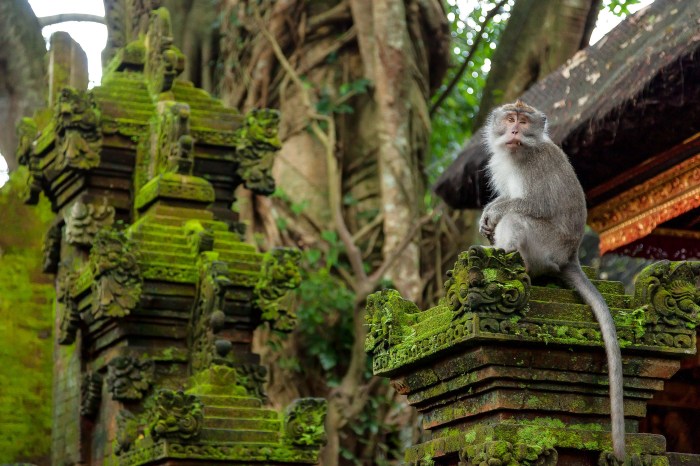
Monkey Forest Ubud is a sacred forest sanctuary in Ubud, Bali, Indonesia. It is home to over 700 long-tailed macaques, and is a popular tourist destination.
The forest has a long history, dating back to the 14th century. It was originally a temple complex, and the monkeys were considered to be the guardians of the temple. Over time, the temple complex fell into disrepair, but the monkeys remained.
Significance to Local Culture and Community
The Monkey Forest is of great significance to the local culture and community. The monkeys are considered to be sacred animals, and are protected by law. The forest is also a popular tourist destination, and provides income for the local community.
The Monkey Forest Ubud, with its playful inhabitants, offers a unique glimpse into the natural world. If you’re looking for a more cosmopolitan experience, consider the iconic marina bay sands singapore , a marvel of modern architecture. Upon your return to Monkey Forest Ubud, immerse yourself once more in the enchanting realm of these curious primates.
Conservation Efforts
The Monkey Forest is facing a number of challenges, including habitat loss, pollution, and tourism. Conservation efforts are underway to protect the forest and its inhabitants. These efforts include reforestation, waste management, and education programs.
Wildlife and Biodiversity
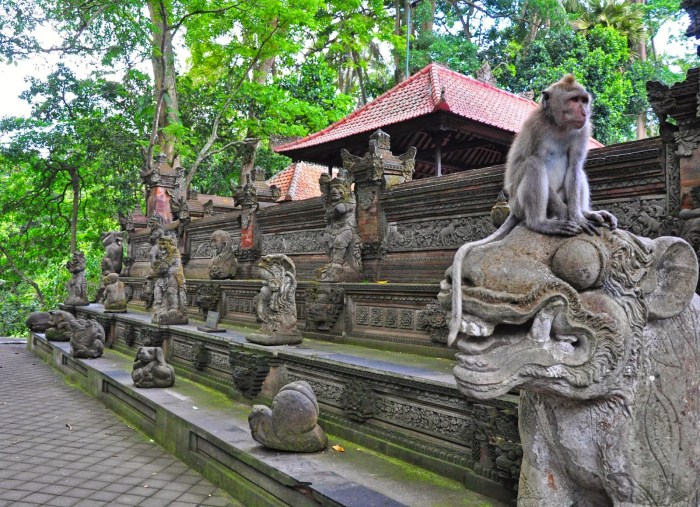
The Monkey Forest Ubud is a sanctuary for a wide range of wildlife, with monkeys being the primary attraction. The forest is home to three species of monkeys: the long-tailed macaque, the pig-tailed macaque, and the Javan langur.
The long-tailed macaque is the most common species in the forest. They are social animals that live in groups of up to 100 individuals. The pig-tailed macaque is a smaller species that is less social than the long-tailed macaque. They live in groups of up to 20 individuals.
The Javan langur is the rarest species in the forest. They are solitary animals that live in the trees.
Behavior and Social Dynamics
The monkeys in the Monkey Forest Ubud have a complex social structure. The long-tailed macaques live in a hierarchical society, with a dominant male at the top. The pig-tailed macaques live in a more egalitarian society, with no clear hierarchy.
Monkey Forest Ubud is a captivating natural sanctuary where you can witness playful macaques in their natural habitat. After exploring the forest, unwind at Sundays Beach Club , where you can indulge in delectable cuisine and soak up the stunning ocean views.
As you return to Monkey Forest Ubud, you’ll appreciate the contrast between the serene jungle and the vibrant beach atmosphere, creating a memorable and diverse experience.
The Javan langurs are solitary animals that only come together to mate.
The monkeys in the Monkey Forest Ubud are very active and playful. They spend their days foraging for food, grooming each other, and playing. They are also very curious and will often approach visitors to the forest.
Role in Supporting Other Wildlife Species, Monkey forest ubud
The Monkey Forest Ubud plays an important role in supporting other wildlife species. The forest provides a habitat for a variety of birds, reptiles, and amphibians. The monkeys also help to disperse seeds, which helps to regenerate the forest.
The Monkey Forest Ubud is a valuable asset to the local community. It is a popular tourist destination and provides a home for a variety of wildlife species.
Cultural and Spiritual Significance

The Monkey Forest, known locally as Mandala Suci Wenara Wana, holds profound cultural and spiritual significance within Balinese Hinduism. It is considered a sacred sanctuary where the spirits of ancestors and deities reside, fostering a deep connection between the forest, the local community, and the divine.
The forest plays a pivotal role in traditional ceremonies and rituals. During the annual Galungan and Kuningan festivals, offerings and prayers are made at the temple within the forest, seeking blessings and protection from the spirits. Devotees believe that the presence of the monkeys symbolizes the forest’s sacred nature and the presence of divine forces.
Legends and Stories
Numerous legends and stories are associated with the Monkey Forest, further enriching its spiritual significance. One tale recounts how a holy man named Mpu Kuturan established the forest as a sanctuary for monkeys in the 14th century. Another legend tells of a powerful sorcerer who transformed himself into a monkey and lived in the forest, guarding its secrets.
Tourism and Visitor Experience
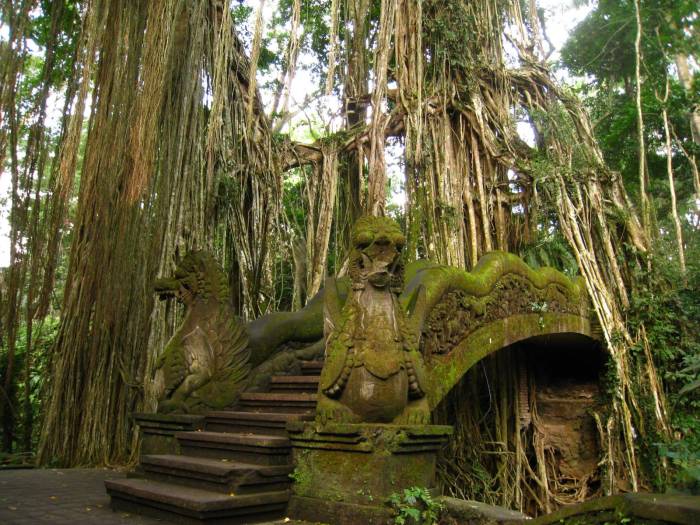
The Monkey Forest Ubud is a popular tourist destination, welcoming thousands of visitors each year. To access the forest, visitors can take a short walk from the center of Ubud or hire a taxi or motorbike. Once inside the forest, visitors will find a range of facilities and amenities, including a visitor center, restrooms, and a cafe.
There are also several trails that wind through the forest, allowing visitors to observe the monkeys in their natural habitat.
Ethical Considerations
When interacting with the monkeys, it is important to be respectful and mindful of their behavior. Visitors should avoid feeding the monkeys, as this can lead to them becoming dependent on humans for food and losing their natural foraging skills.
It is also important to keep a safe distance from the monkeys, as they can sometimes be aggressive, especially if they feel threatened. Visitors should also be aware of their belongings, as the monkeys are known to be opportunistic thieves.
Conservation and Sustainability: Monkey Forest Ubud
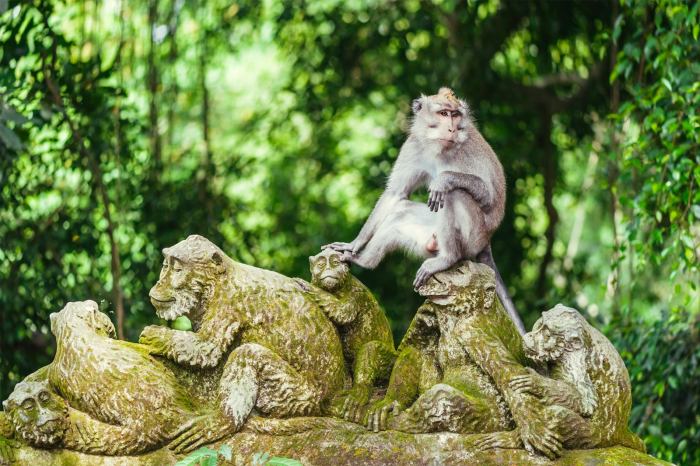
The Monkey Forest of Ubud faces several threats, including habitat loss, fragmentation, and the illegal wildlife trade. Conservation measures have been implemented to protect the forest and its wildlife, including habitat restoration, wildlife monitoring, and community engagement.
The Monkey Forest Ubud is a must-visit for nature lovers, with its playful macaques roaming freely among ancient temples. After your encounter with these fascinating creatures, you can conveniently arrange your departure from Bali airport , located just a short drive away.
Upon your return to the Monkey Forest Ubud, continue exploring its lush greenery and observe the monkeys’ social dynamics in their natural habitat.
Sustainable Tourism Practices
Sustainable tourism practices in the Monkey Forest include limiting visitor numbers, using eco-friendly materials, and educating visitors about the importance of conservation. These practices help to minimize the impact of tourism on the forest and its wildlife.
Ending Remarks
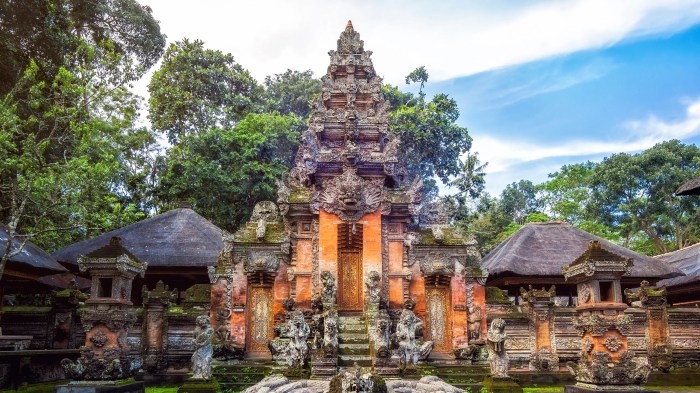
As you bid farewell to Monkey Forest Ubud, let the memories of its enchanting beauty and cultural significance linger in your heart. Remember the importance of respecting the wildlife and preserving this sacred sanctuary for generations to come.
May your visit inspire a deeper appreciation for the delicate balance between nature and spirituality, and leave you with a profound sense of wonder and gratitude.
FAQ Corner
Is it safe to interact with the monkeys?
While the monkeys are generally friendly, it is important to maintain a respectful distance and avoid feeding them. Always follow the instructions of the forest rangers and be mindful of your belongings.
What are the best times to visit the forest?
Early mornings and late afternoons offer the best chances to observe the monkeys at their most active. However, the forest is open daily from 8:30 AM to 6:00 PM.
Are there any entrance fees?
Yes, there is an entrance fee of 80,000 Indonesian Rupiah (approximately $5.50 USD) for adults and 60,000 Indonesian Rupiah (approximately $4.00 USD) for children.